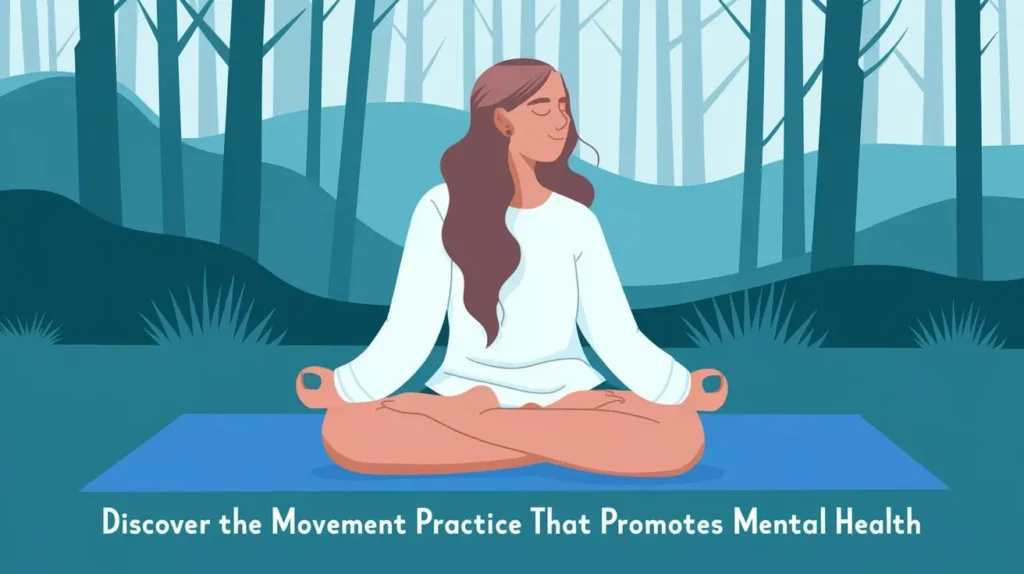In today’s fast-paced world, mental health has become a pressing concern for people of all ages. Stress, anxiety, and depression are widespread, affecting millions globally. While many turn to therapy, medication, or mindfulness techniques for relief, there is a growing recognition of the role movement plays in promoting mental well-being.
One particular movement practice has gained attention for its ability to enhance both physical and mental health: mindful movement. This article explores the connection between movement and mental health, shedding light on how mindful movement can be a powerful tool for mental well-being.
The Connection Between Movement and Mental Health
Movement is more than just a way to keep the body fit. It also plays a crucial role in maintaining mental health. Physical activity triggers the release of endorphins, the body’s natural mood enhancers. These chemicals not only help reduce stress but also improve overall mood and emotional resilience.
Regular movement also reduces the production of cortisol, a hormone associated with stress. High cortisol levels can lead to feelings of anxiety, irritability, and depression. By lowering cortisol levels, movement helps create a calmer and more balanced mental state.
Furthermore, movement encourages better sleep, improves focus, and boosts energy levels. These benefits contribute to a healthier mind, providing a solid foundation for emotional and psychological well-being.
What is Mindful Movement?
Mindful movement is a practice that combines physical exercise with mindfulness, a state of being fully present and engaged in the moment. Unlike traditional workouts that focus solely on physical outcomes, mindful movement emphasizes the connection between the mind and body. This approach encourages individuals to pay attention to how their body feels during movement, fostering a deeper awareness of the present moment.
Mindful movement practices include activities such as yoga, tai chi, Pilates, and qigong. These practices blend slow, deliberate movements with controlled breathing and mental focus. By aligning movement with breath and awareness, individuals experience a sense of calm, clarity, and mental balance.
The Mental Health Benefits of Mindful Movement
Reduces Stress and Anxiety
Mindful movement helps reduce stress by promoting relaxation and calm. The slow, rhythmic movements encourage deep breathing, which activates the body’s parasympathetic nervous system—often referred to as the “rest and digest” system. This helps counteract the effects of the sympathetic nervous system, which triggers the body’s fight-or-flight response to stress.
By slowing the heart rate and calming the mind, mindful movement reduces the physical symptoms of anxiety, such as tension and restlessness. As individuals focus on their breath and movements, their minds become less preoccupied with worry and stress.
Improves Mood
Engaging in mindful movement helps boost mood by increasing the production of endorphins and serotonin—both of which are associated with happiness and emotional well-being. Unlike intense forms of exercise that may feel exhausting, mindful movement is gentle on the body, making it accessible to individuals of all fitness levels.
The practice also fosters a sense of accomplishment and self-compassion. Instead of pushing the body to its limits, individuals are encouraged to move at their own pace, honoring their body’s needs and capabilities. This promotes a positive relationship with the body and mind, which can lead to improved self-esteem and emotional stability.
Enhances Mindfulness and Mental Clarity
Mindful movement encourages individuals to focus on the present moment. This heightened state of awareness helps reduce rumination and overthinking, two common contributors to anxiety and depression. By staying grounded in the present, individuals can let go of negative thought patterns and become more in tune with their thoughts, feelings, and bodily sensations.
As mindfulness improves, so does mental clarity. Mindful movement helps quiet the noise of daily life, allowing individuals to think more clearly and make better decisions. This can be especially beneficial for those struggling with mental health issues, as it helps break the cycle of negative thinking and fosters a more positive mindset.
Promotes Emotional Resilience
Practicing mindful movement regularly helps build emotional resilience. By learning to remain present during difficult moments and focusing on controlled movement, individuals develop a greater sense of self-control. This ability to remain calm and composed in the face of stress or emotional challenges is crucial for maintaining mental well-being.
Mindful movement also teaches individuals how to observe their emotions without judgment. Instead of reacting impulsively to stressful situations, they learn to pause, reflect, and respond mindfully. Over time, this practice enhances emotional intelligence and fosters healthier coping mechanisms.
Encourages Better Sleep
Sleep and mental health are deeply interconnected. Poor sleep can exacerbate feelings of anxiety, depression, and irritability, while restful sleep is essential for emotional stability. Mindful movement promotes relaxation, reduces stress, and helps regulate the body’s natural sleep cycle.
By practicing mindful movement in the evening or before bed, individuals can create a soothing nighttime routine that calms the mind and prepares the body for sleep. The practice helps release tension from the body, making it easier to unwind and fall asleep. As sleep improves, so does overall mental health.
Types of Mindful Movement Practices
Yoga
Yoga is perhaps the most well-known form of mindful movement. It combines physical postures (asanas) with breath control (pranayama) and meditation. Yoga helps individuals connect with their bodies, promoting relaxation and mental focus. Different styles of yoga, such as Hatha, Vinyasa, and Restorative, offer various approaches to mindful movement, making it suitable for beginners and advanced practitioners alike.
Yoga’s emphasis on breath awareness and mindfulness makes it a powerful tool for reducing anxiety, improving mood, and increasing self-awareness. Whether practiced at home or in a class setting, yoga helps individuals cultivate mental calm and emotional balance.
Tai Chi
Tai Chi is a Chinese martial art that focuses on slow, flowing movements and deep breathing. Originally developed for self-defense, Tai Chi is now practiced for its health benefits, particularly its ability to promote mental and physical well-being.
The gentle, repetitive movements of Tai Chi encourage relaxation and mindfulness. Practitioners often describe Tai Chi as a moving meditation, as it requires focused attention on both movement and breath. This practice helps reduce stress, improve mental clarity, and foster emotional resilience.
Pilates
Pilates is a low-impact exercise system that focuses on core strength, flexibility, and posture. Although Pilates is often associated with physical fitness, its emphasis on breath control and concentration makes it a mindful movement practice.
During Pilates sessions, practitioners are encouraged to focus on the quality of their movements rather than the quantity. This mindful approach helps improve body awareness and mental focus. Pilates can be particularly beneficial for those who experience stress-related tension or anxiety, as it helps release physical tension while promoting mental relaxation.
Qigong
Qigong is another Chinese practice that involves coordinated body movements, breath control, and meditation. Like Tai Chi, Qigong promotes the flow of energy (qi) throughout the body, helping to balance the mind and body.
Qigong is often used to improve mental clarity, reduce stress, and enhance emotional well-being. The slow, deliberate movements encourage relaxation and mindfulness, making it a valuable practice for those seeking to improve their mental health.
How to Get Started with Mindful Movement
Starting a mindful movement practice doesn’t require expensive equipment or a gym membership. You can begin practicing at home with just a few minutes each day. Here are some steps to help you get started:
Choose a Practice: Select a mindful movement practice that resonates with you, whether it’s yoga, Tai Chi, Pilates, or another form of mindful movement. Consider your fitness level, personal preferences, and mental health goals when choosing a practice.
Set Aside Time: Dedicate a specific time each day for your practice, even if it’s just 10-15 minutes. Consistency is key to experiencing the mental health benefits of mindful movement.
Focus on Breath and Movement: Pay attention to your breath as you move. Synchronize your breath with each movement, and focus on how your body feels during the practice. If your mind wanders, gently bring your focus back to the present moment.
Practice Self-Compassion: Be kind to yourself as you begin your practice. Don’t worry about perfection or achieving specific goals. Instead, focus on enjoying the process and listening to your body.
Gradually Increase Your Practice: As you become more comfortable with mindful movement, you can gradually increase the duration and intensity of your practice. You may also want to explore different styles or practices to keep your routine fresh and engaging.
Conclusion
Mindful movement is a powerful practice that promotes mental health and emotional well-being. By combining physical movement with mindfulness, practices like yoga, Tai Chi, Pilates, and Qigong help reduce stress, improve mood, and enhance emotional resilience. These practices encourage individuals to stay present, cultivate self-awareness, and develop a healthier relationship with their minds and bodies.
Whether you’re new to mindful movement or a seasoned practitioner, incorporating these practices into your daily routine can have a profound impact on your mental health. By dedicating just a few minutes each day to mindful movement, you can experience greater peace, clarity, and emotional balance in your life.



